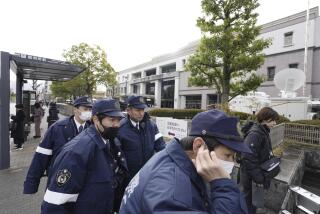Shopping Area Targeted in Yokohama Gas Attack : Japan: Three separate locations at railway station were struck by fumes, police say. No suspects found.
- Share via
TOKYO — Police discovered Thursday that one of the targets of Japan’s second gas attack in a month was a shopping center in the Yokohama Railway Station, but they found no suspects and had no clues about how the gas was released.
The number of people treated for burning eyes, sore throats and nausea rose to 695, with six still hospitalized. No one was seriously afflicted.
Police said the noxious gas was released in three locations in the Yokohama Station: the shopping center, a subterranean passageway and a train passing through about 1 p.m. Wednesday. Police reportedly concluded that a team of criminals must have perpetrated the attacks.
The absence of evidence and the inability to confirm what chemical substance was used, however, fueled tensions in the government of Prime Minister Tomiichi Murayama.
Adding to the strain was the fact that, one month after a sarin nerve gas attack on Tokyo’s subways killed 12 and afflicted more than 5,500, no suspects have been named and no arrests directly connected with the attack have been made.
The Aum Supreme Truth cult is at the center of suspicion in the March 20 attack in Tokyo.
Police raids on its facilities have turned up tons of potentially deadly chemicals, and more than 100 of its members have been arrested on charges ranging from kidnaping to violations of building codes.
Education Minister Kaoru Yosano predicted that the charges will ultimately include homicide. If those charges are brought, he said, he will urge that court proceedings be launched to dissolve the doomsday sect.
Yuko Sekiguchi, deputy chief of the National Police Agency, told a news conference that investigations into the sarin gas attack “are progressing smoothly, with one leader after another of Aum being arrested.”
Among those arrested are four close aides of Supreme Truth founder Shoko Asahara, 40, but none of those in custody have been accused of any link with the attacks in Tokyo and Yokohama.
Justice Minister Isao Maeda, meanwhile, testified in Parliament that his ministry will begin a study of whether to use police infiltrators, eavesdropping and legal bargaining in investigating terrorists in the future.
None of those tactics, which are used in the United States, have been permitted in Japan since the end of World War II.
NHK, the semi-governmental TV network, reported that four people who suffered sarin poisoning in the Tokyo subway attack remain hospitalized. Two of them, the network added, are unconscious and in serious condition.
In a book to be released next week, Asahara claims to be seriously ill, Kyodo News Agency reported, saying it has obtained a partial manuscript.
Asahara wrote that he is suffering “heart disease and cerebral thrombosis,” Kyodo said. “I am now devoting my life to fighting my illness,” he is quoted as writing.
The news agency said Asahara repeats his doomsday prophecy that “the world as we know it will come to an end in 1997” in an Armageddon of nerve gas and biological wars pitting Christians against Buddhists. Supreme Truth followers, he declares, must become self-sufficient to survive the devastation.
More to Read
Sign up for Essential California
The most important California stories and recommendations in your inbox every morning.
You may occasionally receive promotional content from the Los Angeles Times.













